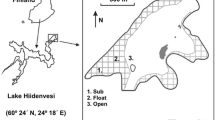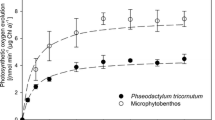Abstract
Microprofiles of oxygen were measured by 2- to 10-μm diameter microelectrodes within 0.2- to 2.0-mm thick epiphyte layers on different marine and freshwater macrophytes during artificial light-dark cycles. The epiphyte community created large fluctuations in oxygen concentrations at the macrophyte surface by increasing the thickness of the layer around the macrophyte in which the transport of solutes occurred by molecular diffusion and by contributing to the combined epiphyte-macrophyte activity. When epiphytes were removed, the diffusive boundary layer was reduced to 100 to 200 μm, and oxygen fluctuations declined. The oxygen concentration at the epiphyte-coverted macrophyte surface varied the most with the photosynthetically very active Scytosiphon lomentaria (Lyngb.), i.e. from 3 times atmospheric saturation of oxygen in the light to 0 in the dark. Low photosynthetic activity and extensive air lacunae in leaves of Littorella uniflora (L.) Aschers reduced oxygen fluctuations and extended the period necessary to reach steady state oxygen profiles. Detailed analysis of the epiphyte community on Potamogeton crispus L. showed that oxygen exchange followed typical light-photosynthesis saturation curves without exhibiting photoinhibition. The light compensation point of the association, (20–37 μE m-2s-1), and the saturation point, Ik (105–135 μE m-2s-1), were both low despite extensive self-shading. With increasing age under nutrient limitation, oxygen release of the epiphyte-P. crispus association under saturating illumination dropped from 10.0 to 5.0 nmol O2 cm-2 min-1, whereas the dark consumption remained about the same (2.4 to 2.9 nmol O2 cm-2 min-1). The contributions of the epiphyte community and the macrophyte to these oxygen exchanges were about equal. Epiphyte communities attenuate light and increase the transfer resistance for fluxes of dissolved substances between the bulk phase and the plant surface. Dense epiphyte communities which develop in eutrophicated waters may therefore be a severe stress to macrophyte metabolism by shading and by generating anoxic conditions at the macrophyte surface in the dark and high O2 and low CO2 concentrations in the light.
Similar content being viewed by others
Literature cited
Drew, M. C.: Plant responses to anaerobic conditions in soil and solution culture. Curr. Adv. Plant Sci. 36, 1 (1979)
Eichenberger, E.: On the quantitative effects of chemical factors on running water ecosystems. Schweiz. z. Hydrol. 37. 21–34 (1975)
Harris, G. P.: Photosynthesis, productivity and growth: the physiological ecology of phytoplankton. Ergeb. Limnol. 10, 1–171 (1978)
Hunding, C.: Production of benthic microalgae in the littoral zone of a eutrophic lake. Oikos 22, 389–397 (1971)
Jeppesen, E.: Organisk stof i Holme å. MS Thesis, 155 pp. University of Copenhagen: Freshwater Biological Laboratory 1978
Jørgensen, B. B. and N. P. Revsbech: Diffusive boundary layers and the oxygen uptake of sediments and detritus. Limnol. Oceanogr. 30, 111–122 (1985)
Lorimer, G. H.: The carboxylation and oxygenation of ribulose 1,5-bis phosphate carboxylase: the primary events in photosynthesis and photorespiration. Ann. Rev. Plant Physiol. 32, 349–383 (1981)
Marshall, E. J. P.: The ecology of a land drainage channel I. Oxygen balance. Wat. Res. 15, 1075–1085 (1981)
Orth, R. J. and K. A. Moore: Chesapeake Bay: an unprecedented decline in submerged aquatic vegetation. Science, N.Y. 222, 51–53 (1983)
Phillips, G. L., D. Eminson and B. Moss: A mechanism to account for macrophyte decline in progressively eutrophicated fresh-waters. Aquat. Bot. 4, 103–126 (1978)
Prins, H. B. A., J. F. H. Snel, P. E. Zanstra and R. J. Helder: The mechanisms of bicarbonate assimilation by the polar leaves of Potamogeton and Elodea. CO2 concentrations at the leaf surface. Plant Cell Envir 5, 207–214 (1982)
Revsbech, N. P.: In situ measurements of oxygen profiles of sediments by use of oxygen microelectrodes. In: Polarographic oxygen sensors, Ch. III 2, pp 265–273. Ed. by Gnaiger/Forstner. Berlin: Springer-Verlag 1983
Revsbech, N. P., B. B. Jørgensen and O. Brix: Primary production of microalgae in sediments measured by oxygen microprofile, H14CO -3 -fixation, and oxygen exchange methods. Limnol. Oceanogr. 26, 717–730 (1981)
Revsbech, N. P. and B. B. Jørgensen: Photosynthesis of benthic microflora measured with high patial resolution by the oxygen microprofile method: Capabilities and limitations of the method. Limnol. Oceanogr. 28, 749–756 (1983)
Revsbech, N. P., B. B. Jørgensen, T. H. Blackburn and Y. Cohen: Microelectrode studies of the photosynthesis and O2, H2S and pH profiles of a microbial mat. Limnol. Oceanogr. 28, 1062–1074 (1983)
Revsbech, N. P., J. Sørensen, T. H. Blackburn and J. P. Lomholt: Distribution of oxygen in marine sediments measured with microelectrodes. Limnol. Oceanogr. 25, 403–411 (1980)
Revsbech, N. P. and D. M. Ward: Oxygen microelectrode that is insensitive to medium chemical composition: use in an acid microbial mat dominated by Cyanidium caldarium. Appl. environ. Microbiol. 45, 755–759 (1983)
Sand-Jensen, K.: Effect of epiphytes on eelgrass photosynthesis. Aquat. Bot. 3, 55–63 (1977)
Sand-Jensen, K.: Physical and chemical parameters regulating growth of periphytic communities. In: Periphyton of freshwater ecosystem, Ch. 10, pp 63–71. Ed. by R. G. Wetzel. The Hague: Dr. W. Junk Publishers 1983
Sand-Jensen, K. and J. Borum: Regulation of growth of eelgrass (Zostera marina L.) in Danis coastal waters. Mar. Techn. Soc. J. 17, 15–21 (1983)
Sand-Jensen, K. and J. Søndergaard: Phytoplankton and epiphyte development and their shading effect on submerged macrophytes in lakes of different nutrient status. Int. Revue ges. Hydrobiol. 66, 529–552 (1981)
Stumm, W. and J. J. Morgan: Quatic chemistry. An introduction emphasizing chemical equilibria in natural waters. New York: Wiley-Interscience 1970
Vogel, S.: Life in moving fluids. Boston: Willard Grant Press 1981
Wheeler, W. N.: Effect of boundary layer transport on the fixation of carbon by the giant kelp Macrocystis pyrifera. Mar. Biol. 56, 103–110 (1980)
Author information
Authors and Affiliations
Additional information
Communicated by T. Fenchel, Aarhus
Rights and permissions
About this article
Cite this article
Sand-Jensen, K., Revsbech, N.P. & Barker Jørgensen, B. Microprofiles of oxygen in epiphyte communities on submerged macrophytes. Mar. Biol. 89, 55–62 (1985). https://doi.org/10.1007/BF00392877
Accepted:
Issue Date:
DOI: https://doi.org/10.1007/BF00392877




